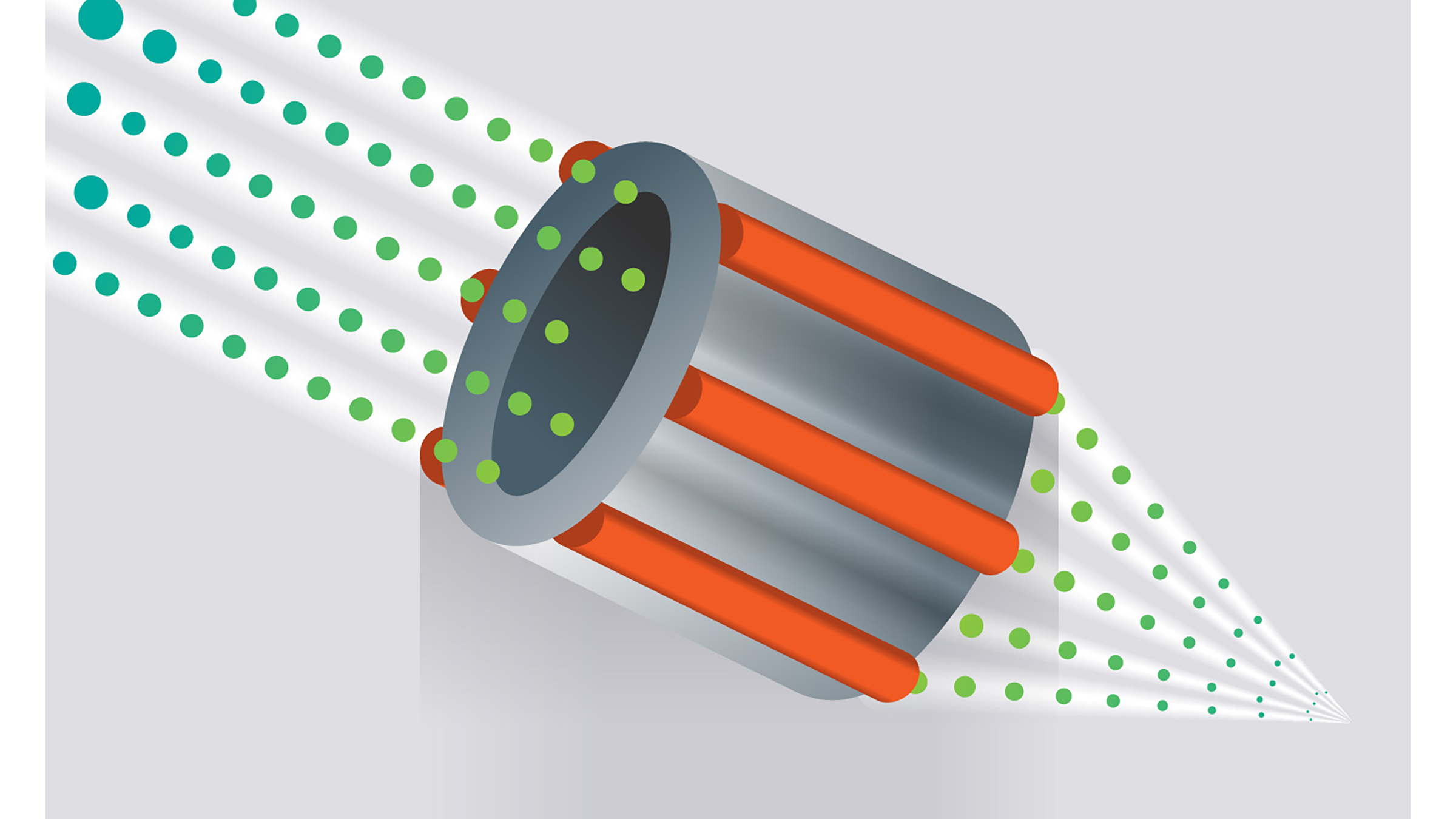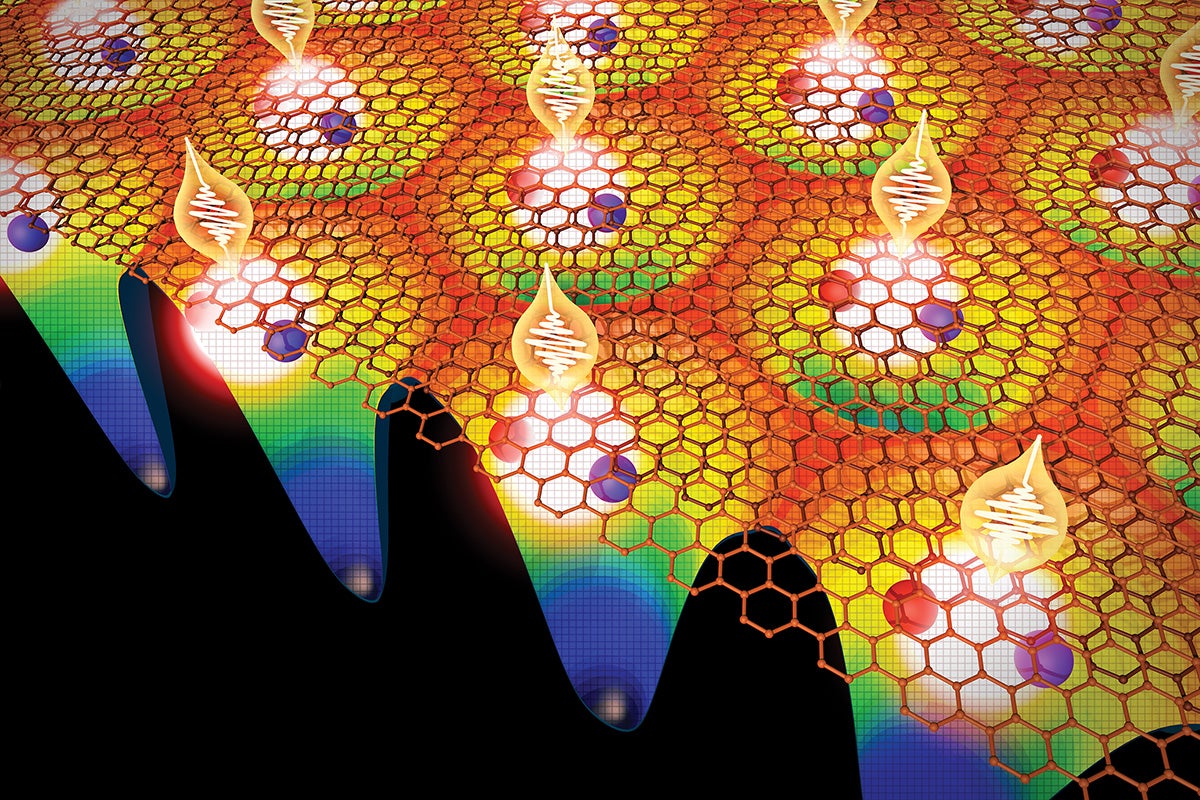Physicists Improve Key Component of Future Atom Microscope
Learn about how Mark Raizen and his team at UT Austin have developed the world's highest resolution atom lens.

An atom lens is analogous to a glass lens used in an optical microscope or magnifying glass, but rather than focusing a beam of light, it focuses a beam of atoms down to a spot. Illustration: Jenna Luecke.
Mark Raizen, a professor of physics at The University of Texas at Austin, and his team have developed the world's highest resolution atom lens, a key component of a new kind of microscope called an atom microscope, which can image the surface of a material at the atomic scale and reveal its chemical composition.
An atom microscope could be useful in many applications, such as discovering better catalysts for faster chemical reactions. That's because the performance of a catalyst is heavily dependent upon the chemistry of its surface. Raizen believes many more applications will arise as scientists use atom microscopes to ask questions that were difficult to answer before and explore areas that once seemed off limits.
An atom lens is analogous to a glass lens used in an optical microscope or magnifying glass, but rather than focusing a beam of light, it focuses a beam of atoms down to a spot.
The work, published February 22nd in the Journal of Chemical Physics, was performed by Raizen in conjunction with lead author Jamie Gardner and co-author Erik Anciaux, both graduate students in the Raizen Laboratory.
Imaging the surface of a material at the scale of atoms is a hard problem for most types of microscopes, including electron microscopes that work by hitting the material with electrons, since electrons can penetrate deeper into the material than just the surface. Moreover, many microscopes are only capable of capturing the shape or topography of the surface, or the chemical composition, but not both. Yet many of the important properties of a material, such as how it behaves in a chemical reaction, are heavily dependent upon both the chemical composition and shape of the surface.
The atom lens, which is part of a new field of physics called atom optics, is a fundamental step towards building an atom microscope which can accurately capture both the surface shape and chemical composition of a material.
Similar to an electron microscope, an atom microscope would work by bombarding the surface of a material with energetic particles. However, instead of using electrons, which could penetrate the surface of the material, the microscope would use neutral neon atoms which are in an excited state, meaning that their electrons have more energy than usual. The benefit of this approach is that the atoms cannot go deeper into the material than the surface. Whenever the neon atoms hit the surface they will also excite the electrons in the atoms of the surface, and this will cause the surface to give off electrons with a specific energy distribution which are unique to specific elements.
The atom lens is a hollow tube surrounded by six thin wires that form an electromagnet. The scientists inject a beam of excited state neon atoms into one end of the tube and send electromagnetic pulses through the tube in a pattern that focuses the beam down to a point. The magnetic field inside the tube is well suited for focusing atoms, but the magnetic field on the outside can have 'fringe' effects, meaning it is not as well controlled and can distort the image. Raizen's atom lens has an electromagnet that can pass a large amount of current very fast, allowing it to avoid those fringe effects.
Other atom lenses have been made before, but the fringe effects of the magnetic field interfered heavily with their ability to focus an image, since they used permanent magnets. The unique design of Raizen's atom lens, including the use of a pulsed electromagnet and the unique hexapole design of the electromagnet, yield much higher resolution than previous attempts at atom lenses and is a big step towards a useable atom microscope.
Raizen and his team tested the atom lens by shooting a beam of neon atoms through a slit and testing to see how accurately the lens could focus the resulting image. They also did a more qualitative test by focusing beams of neon in the shape of a longhorn and other objects and seeing how well their lens could focus it.
The next steps towards an atom microscope are in reducing the effect of aberrations, meaning errors in the imaging which arise from imperfections of the lens, or other effects which might distort the image. Traditional microscopes do this using a system of lenses instead of a single lens, and Raizen's team is hoping to find a similar solution for atom microscopes.



